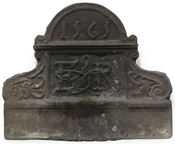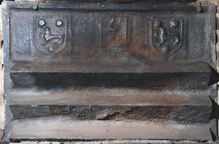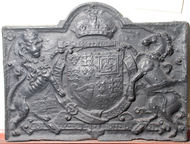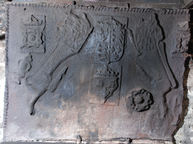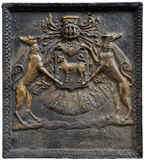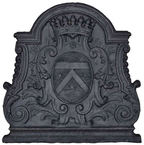-
261
Description: Plain rectangular bottom panel with fillet on top; above, rectangular panel with fillet and ovolo-moulded edging, within which the initials, ER, ornately carved, intertwined with floral tendrils; on each side, a scrolled bracket with double fillet edging, enclosing [?] ears of corn; on top, a narrow cornich, with an arch above, scrolled at each end and with double fillet edging, enclosing the date, possibly formed of individual stamped letters.
Notes: The 'ER' initials should not be assumed to be those of Elizabeth I. Formerly at Ockwells Manor, Cox Green, Berkshire. Christie's auction 4 Nov 2008 lot 259 (£3,750).
Copies of this fireback are known.
Inscription: 1565 / ER
- Decoration tags:
- quasi-arched rectangular (shape)
- complex individual (edging)
- whole carved pattern
- individual numbers
- text
- plants
Manufactured: in 1565 in the Weald area of England.
Current location: not known.
- Attached to series:
- Personal firebacks
- Date & initials firebacks
-
359
Description: Rectangular; double fillet moulded edging; top centre, shield-shaped block with a rectangle containing the crest of the Fowles - an Arm in armour holding a Battle axe issuant from a Ducal Coronet, above the initials, WF; top left and right, two shields of the arms of the Fowle family - (Gules) a lion passant guardant between three roses (Or); across the lower half of the fireback are three solid triangular prisms of iron.
Notes: The stamps relate to William Fowle (1568-1634), ironmaster of Riverhall furnace. The stamps also appear on grave slabs in Wadhurst and Frant churches and on an unprovenanced graveslab in Maidstone Museum. The iron prisms were included, perhaps, to retain heat and to prevent the fireback from cracking.
Inscription: WF
Arms: William Fowle, of Frant and Wadhurst
- Decoration tags:
- rectangular with triangular bars (shape)
- fillet (edging)
- carved stamps
- heraldic
- armorial
- text
Manufactured: in the early 17th century probably at Riverhall Furnace, Wadhurst in the Weald area of England.
Current location: in private hands, Lamberhurst, Kent, England.
- Attached to series:
- Fowle series
-
405
Description: Arched rectangular shape with small rhomboidal flanges in the corners of the arch; cavetto moulded edge on all sides; Stuart royal arms (1605-88, 1702-14) with lion and unicorn supporters, garter, crown and motto; raised inscription in a tapering label beneath crown.
Notes: An amended copy of a 17th/early 18th century original (see no. 633). The added inscription has been impressed with the personalised cast handle of a cooking vessel. A bronze skillet bearing the inscription 'STANDEN 1726' on its handle has been recorded elsewhere, but the impression on the fireback has been formed from a handle with the inscription inset in relief, whereas the 1726 inscription is inscribed. Also the lettering on the handle used to personalise the fireback, which includes the letter A surmounted with a horizontal line, is of an earlier style. Three members of the Standen family, Thomas, James and Elias, were founders at Beech or Robertsbridge furnaces, Sussex, 1728-9, and a John Standen was casting skillets at Heathfield Furnace in the early 1730s; each could have been the founder of the 1726 skillet, but the maker of the handle used in the fireback casting may have been earlier. Formerly at Marshalls Manor House, Maresfield, Sussex.
Inscription: IAMES STANDEN [+Garter and royal mottoes]
Arms: English Stuart royal
- Decoration tags:
- arched rectangular (shape)
- cavetto (edging)
- carved pattern panels
- whole carved pattern
- armorial
- royal
- text
Manufactured: in the late 17th to early 18th century in the Weald area of England.
Current location: Anne of Cleves House, Southover High Street, Lewes, East Sussex, England.
Museum number: LH000.943 (part of the Sussex Archaeological Society museum group)
Citation: Dawson, C., 1903, 'Sussex Iron Work and Pottery', Sussex Archaeological Collections, 46, pp. 1-54.
- Attached to series:
- Stuart royal armorial firebacks
- Miscellaneous stamp firebacks
-
463
Description: Fragment; rectangular; twisted rope edging (top and side); top centre, crowned Tudor royal shield (over-pressed) above a crowned shield (over-pressed) bearing initials above a fleur-de-lys; to left, a leopard passant guardant sinister diagonally position with its rear toward the bottom left corner; to right, a leopard passant, also diagonally positioned, its rear towards the bottom right; in the top corners, a crowned four-petalled rose (over-pressed); below the left rose, a left-directed ‘imp’ figure looking right, its arms lowered; bottom right, a left-directed ‘imp’ figure, its left arm raised; to right of the lower shield, a four-petalled rose askew.
Notes: One of the ‘Royal’ series.
Arms: Tudor royal arms of England
- Decoration tags:
- rectangular (shape)
- rope (edging)
- carved stamps
- heraldic
- armorial
- royal
- animals
- humans
Manufactured: in the mid 16th century in the Weald area of England.
Current location: in private hands, Little Horsted, East Sussex, England.
- Attached to series:
- Royal series
-
1040
Description: Rectangular; faux-ruche cavetto-moulded edging; upper centre, shield, helm, crest, mantling and greyhound supporters on a compartment; behind the arms is what appears to be a gown spread out, comprising bands of ermine.
Notes: Blazon: Azure, a bull passant or. Jean Bouhier de Savigny (1673-1746) was President of the Parliament of Burgundy from 1704. He was also a historian, translator, scholar and bibliophile. He resigned his post in Parliament in 1728 to devote himself to his historical and literary work following his election to the French Academy in 1727.
Arms: Jean Bouhier de Savigny
- Decoration tags:
- rectangular (shape)
- faux ruche (edging)
- whole carved pattern
- heraldic
- armorial
Manufactured: in the early to mid 18th century in France.
Current location:, not known.
Citation: Carpentier, H., 1912, Plaques de Cheminées (Paris & Florange, published by the author).
- Attached to series:
- Foreign armorial firebacks
-
965
Description: Upon a moulded base plinth, wide scrolled side double fillets with foliage about the scrolls and suspended bell flowers in chain above; central foliate cartouche behind an oval shield surmounted by a viscomte's coronet; on top, an arch rising from horizontal moulding on each side.
Notes: Blazon: Azure, a chevron Argent between three estoiles Or, all surmounted by a bar of the second; characteristic of designs illustrated by architects such as Daniel Marot; the texturing on the shield indicates the azure tincture. See Carpentier p. 234, fig. 644.
Arms: Besset de la Chapelle
- Decoration tags:
- quasi-arched rectangular (shape)
- complex individual (edging)
- whole carved pattern
- armorial
Manufactured: in the late 17th to early 18th century in France.
Current location:, not known.
Citation: Carpentier, H., 1912, Plaques de Cheminées (Paris & Florange, published by the author).
- Attached to series:
- Foreign armorial firebacks
